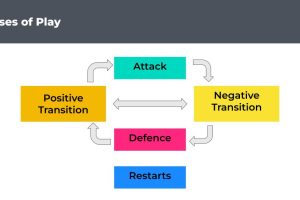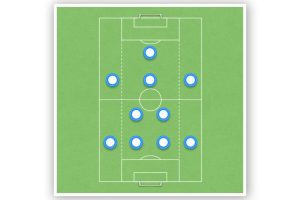Soccer Man Marking: A Comprehensive Guide
One of the most effective and underused defensive tactics in soccer (when done right) is man marking. Man marking is when defenders are assigned to closely mark specific opposing players, often the most dangerous ones, in order to limit their impact on the game.
Man marking can be used in different ways, depending on the situation and the team’s strategy. For example, a team may use zonal marking for most of the game, but switch to man marking for set pieces or when facing a particularly skilled player. Individual man marking is when one defender is assigned to mark one specific opponent, while collective man marking involves multiple defenders working together to mark different players.
| Advantages of man marking | Disadvantages of man marking |
|---|---|
| Prevents dangerous players from receiving the ball | Requires high level of concentration and communication |
| Allows for quick and aggressive pressing | Can lead to leaving other players unmarked |
| Can disrupt the opponent’s attacking rhythm | May not work against teams with fluid or unpredictable movements |
What is Soccer Man Marking?
As a soccer player, I know that man marking is a defensive strategy where a defender is assigned to mark a specific opponent. The defender’s main objective is to prevent the opponent from playing any part in a goal, making a pass, or even receiving a pass from a teammate.
Man marking is a popular defensive tactic that is widely used in soccer throughout the world. Although, these days it’s more used in small parts as opposed to a full man-on-man press. It can provide tactical simplicity by allowing each player to know which offensive player they are responsible for during the match. This marking tactic is usually used during set-pieces, such as corners, free-kicks, or throw-ins, when the opposing team is likely to score.
Man marking is different from zonal marking, where defenders are responsible for a specific area of the field rather than a specific player. However, even in zonal marking, there is some man marking or at least responsibility for those players that come into your space.
| Pros | Cons |
|---|---|
| Prevents the opponent from playing any part in a goal | Can leave other players unmarked |
| Provides tactical simplicity | Requires a high level of fitness and concentration |
| Effective during set-pieces | Can be risky if the defender is beaten |
Man marking can be very effective if done correctly. However, it requires a high level of fitness and concentration from the defender. If the defender is beaten, it can be risky and leave other players unmarked. Therefore, it is important to weigh the pros and cons of man marking before deciding to use it as a defensive tactic.
For example, in the 2010 World Cup final, the Netherlands used man marking to try and stop Spain’s star player, Andres Iniesta. However, this tactic was unsuccessful, and Iniesta went on to score the winning goal for Spain in extra time.
The Benefits of Soccer Man Marking
Improved Defensive Performance
As a defender, man marking is a great way to improve your defensive performance. With man marking, you are assigned an opposing player to mark and defend against. This means that you always know who you are responsible for, and you can focus on stopping that player from scoring or creating chances.
Man marking also allows you to be more aggressive in your defending. By staying close to your opponent, you can anticipate their movements and intercept passes, making it more difficult for them to get past you and create scoring opportunities.
Reduced Opposition Scoring Opportunities
One of the main benefits of man marking is that it reduces the opposition’s scoring opportunities. By assigning a defender to mark each opposing player, it becomes more difficult for the opposition to find open space and create chances.
Man marking is particularly effective against teams with good aerial ability. By staying close to your opponent, you can win individual aerial battles and prevent the opposition from scoring from headers or other set pieces.
| Benefits of Soccer Man Marking | Description |
|---|---|
| Improved Defensive Performance | Man marking allows defenders to focus on stopping their assigned opponent, improving their defensive performance and making them more aggressive in their defending. |
| Reduced Opposition Scoring Opportunities | Man marking reduces the opposition’s scoring opportunities by assigning a defender to mark each opposing player and preventing them from finding open space and creating chances. |
For example, in a game between Manchester United and Liverpool, Liverpool had a corner kick in the 87th minute. Manchester United used man marking to defend the corner kick, assigning a defender to mark each Liverpool player. As a result, Liverpool was unable to create any scoring opportunities from the corner kick, and Manchester United was able to hold on for a 1-0 victory.
Man marking is a highly effective defensive tactic that can improve your defensive performance and reduce the opposition’s scoring opportunities. By staying close to your opponent and focusing on stopping them from scoring or creating chances, you can help your team win games and keep clean sheets.
The Drawbacks of Soccer Man Marking
Increased Risk of Defensive Errors
One of the main drawbacks of man marking in soccer is that it can lead to defensive errors. When defenders are assigned to mark specific players, they may become too focused on their assigned player and lose sight of other attacking players who may be making runs or moving into dangerous positions. This can create gaps in the defense that can be exploited by the attacking team.
Additionally, man marking requires defenders to stay very close to their assigned player, which can make it easier for the attacking player to draw fouls and penalties. This can result in free kicks and penalties being awarded to the attacking team, which can be very dangerous in the attacking third of the field.
Higher Physical Demands on Defenders
Man marking in soccer can also place higher physical demands on defenders. When defenders are assigned to mark specific players, they must constantly track their assigned player and be ready to react to their movements. This can be very physically demanding, especially if the attacking player is quick and agile.
Additionally, man marking can require defenders to engage in physical battles with their assigned player, which can be very tiring and can increase the risk of injury. This is especially true when defending set pieces, such as corner kicks or free kicks, where there is a lot of physical contact between players.
| Drawbacks | Examples |
|---|---|
| Increased risk of defensive errors | Defenders losing sight of other attacking players, drawing fouls and penalties |
| Higher physical demands on defenders | Constantly tracking assigned player, engaging in physical battles, risk of injury |
How to Implement Soccer Man Marking
Defensive Line Setup
When implementing man marking in soccer, it’s important to set up your defensive line correctly. The defensive line should be positioned in a way that allows them to stay goal side and closer to their own goal than the attackers they’re marking. This makes it less likely for the attacking player to have a genuine goalscoring opportunity as the defender acts as an obstacle.
It’s also important to ensure that the defensive line is not too deep or too high up the field. If the line is too deep, it can give the attacking team more space to work with, while a high line can leave the defenders exposed to through balls and counterattacks.
Player Selection
When selecting players for man marking, it’s important to choose players who are disciplined, quick, and agile. These players should be able to stick tight to their opponents when defending and be constantly on the move to lose their marker and score a goal when attacking.
It’s also important to ensure that players are familiar with their opponents’ strengths and weaknesses. This can help them anticipate their movements and limit their influence on the game.
Training and Practice
Training and practice are essential for implementing man marking successfully. Players should be trained to stay tight to their opponents when defending and to constantly move to lose their marker when attacking.
Drills and small-sided games can be used to simulate game situations and help players develop their man marking skills. Coaches should also use video analysis to help players identify areas where they can improve their man marking.
| Key Points | Examples |
|---|---|
| Defensive line should stay goal side and not be too deep or too high up the field | Defenders should position themselves closer to their own goal than the attackers they’re marking |
| Choose disciplined, quick, and agile players for man marking | Players should be familiar with their opponents’ strengths and weaknesses |
| Use drills and small-sided games to simulate game situations | Video analysis can help players identify areas for improvement |
Soccer Man Marking Strategies
Zonal Marking
Zonal marking is a defensive strategy where players are assigned zones on the field to defend. Each player is responsible for defending a specific area of the field rather than marking an individual player. This strategy is effective when defending set pieces such as corner kicks and free kicks. The players must work together to ensure that all zones are covered, and they must communicate effectively to switch zones when necessary.
Man-to-Man Marking
Man-to-man marking is a defensive strategy where each player is assigned to mark an individual player on the opposing team. This strategy is effective when defending against a team with key players who pose a significant threat to the defense. The defenders must stay close to their assigned player and prevent them from receiving the ball or making a pass. This strategy requires a high level of discipline and communication among the defenders.
Mixed Marking
Mixed marking is a combination of zonal and man-to-man marking. This strategy is effective when defending against a team with a mix of strong and weak players. The defenders will use zonal marking to defend against the weaker players and man-to-man marking to defend against the stronger players. This strategy requires a high level of flexibility and adaptability from the defenders.
| Strategy | When to use | Advantages | Disadvantages |
|---|---|---|---|
| Zonal Marking | Defending set pieces | Effective at covering large areas of the field | Requires good communication and coordination |
| Man-to-Man Marking | Defending against key players | Effective at neutralizing individual threats | Requires high level of discipline and communication |
| Mixed Marking | Defending against a mix of strong and weak players | Flexible and adaptable | Requires good judgement and decision-making |
It is important for a team to have a clear understanding of the different marking strategies and when to use them. The strategy chosen will depend on the strengths and weaknesses of the opposing team, as well as the strengths and weaknesses of the defending team. By using a combination of these strategies, a team can effectively defend against any opponent.








